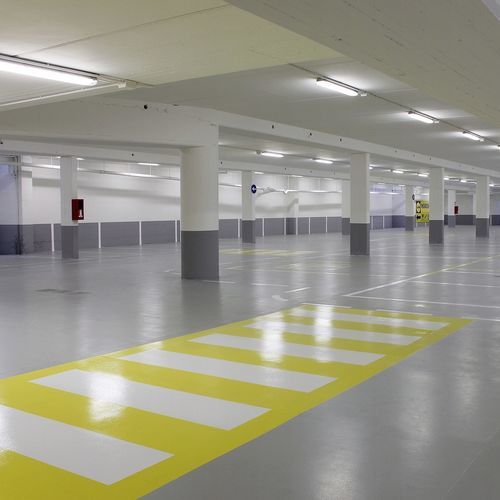
#Product Trends
Resin floors for ESD environments: Protect your sensitive electronic devices.
Sivit Flooring ESD
Resin floors designed for ESD (electrostatic discharge) environments play a crucial role in protecting sensitive electronic devices from harmful electrostatic discharge. In environments where electronic components are managed or produced, even a small electrostatic discharge can cause damage to devices.
What are electrostatic charges?
Electrostatic discharge (ESD) is a phenomenon that occurs when there is a sudden flow of electric current between two objects with different electrical potentials. It often happens when an object accumulates an excess of electrical charge relative to its surroundings and then discharges that accumulated charge to another object or the surrounding environment. ESD can have various effects, from harmless to harmful, depending on the magnitude of the discharge and the sensitivity of the objects involved.
Here's how electrostatic discharge works:
Charge build-up: When two objects come into contact or rub against each other, electrons can transfer from one object to another, leading to an imbalance of electric charge. This can result in one object charging positively (losing electrons) and the other negatively charged (gaining electrons).
Charge separation: If objects electrically isolate from each other, they can maintain their charge imbalances due to the insulating properties of the materials. This separation of charges creates an electric potential difference between objects.
Discharge: When the potential difference between charged objects becomes large enough, it can overcome the insulating barriers between them. At this point, an electrostatic discharge occurs, in which electrons flow rapidly from the negatively charged object to the positively charged one, or vice versa. This sudden flow of electric current is what we perceive as a spark or shock.
ESD can have both positive and negative effects:
Positive effects:
Lightning: Lightning is a natural form of electrostatic discharge that occurs between a cloud and the ground or between two clouds. It helps balance charges in the atmosphere and can play a role in the nitrogen cycle by creating nitrogen oxides.
Negative effects:
Damage to electronics: ESD can cause damage to sensitive electronic components and devices, such as integrated circuits, transistors, and computer chips. Even a small discharge can disrupt the functionality of these components or make them permanently non-functional.
Fires and explosions: In certain environments, electrostatic discharge can ignite flammable gases, vapours, or dusts, which can cause fire or explosion.
Human safety concerns: ESD can also pose risks to human safety. When a person experiences ESD, they may experience sudden shock or discomfort. In some cases, particularly in industries where flammable materials are present, ESD can lead to serious accidents.
To mitigate the risks associated with ESD, various measures are taken, such as the use of antistatic materials, grounding equipment and personnel, and the adoption of protective measures in industries where ESD-related risks are important.
Importance of using an ESD flooring
ESD flooring is designed to dissipate static electricity safely, preventing the build-up of electrostatic charges and safeguarding electronic devices. Here's how resin floors provide the necessary protection:
1. Conductive or dissipative properties: ESD resin floors are formulated with conductive or dissipative properties. Conductive floors have lower electrical resistance, providing a direct path for static charge dissipation at a grounding point. Dissipative floors have increased electrical resistance, slowing down the flow of static charges and preventing rapid discharge.
2. Grounding: ESD resin floors are connected to an appropriate grounding system to ensure that any accumulated static charges are safely discharged to the ground. Conductive or dissipative flooring is part of an ESD control system that includes wrist straps, footwear, and other ESD protective devices.
3. ESD Compliance: ESD Ambient Resin Floors are designed to meet specific ESD standards, such as ANSI/ESD S20.20 and IEC 61340-5-1. Compliance with these standards ensures that the flooring system effectively controls electrostatic charges and prevents damage caused by electrostatic discharge.
4. Seamless and non-porous surface: Like standard resin floors, ESD resin floors are applied as seamless and non-porous surfaces. This eliminates gaps and joints where static charges could build up and helps maintain a clean and hygienic environment.
5. Employee safety: ESD resin floors not only protect electronic devices, but also safeguard workers from potential ESD incidents. Properly grounded flooring prevents workers from experiencing discomfort or bumps due to static electricity.
6. Durability and Longevity: ESD resin floors offer the same high durability and long life as traditional resin floors. They withstand heavy pedestrian traffic and mechanical stress, ensuring continuous ESD protection over time.
7. Minimal maintenance: ESD resin floors typically require minimal maintenance. Regular cleaning with approved ESD cleaners and adhering to proper ESD control procedures help maintain the effectiveness of the flooring.
8. Customization and Aesthetics: ESD resin floors are available in assorted colours and finishes, allowing companies to customize flooring to fit the aesthetics of their structure while meeting ESD requirements.
By incorporating ESD resin floors into sensitive areas for handling electronic devices, companies can effectively control electrostatic charges, prevent damage related to electrostatic discharge, and ensure worker safety and electronic component integrity. These floors play a crucial role in creating a controlled and safe environment for the electronics industry, where protection from electrostatic discharge is of paramount importance.






